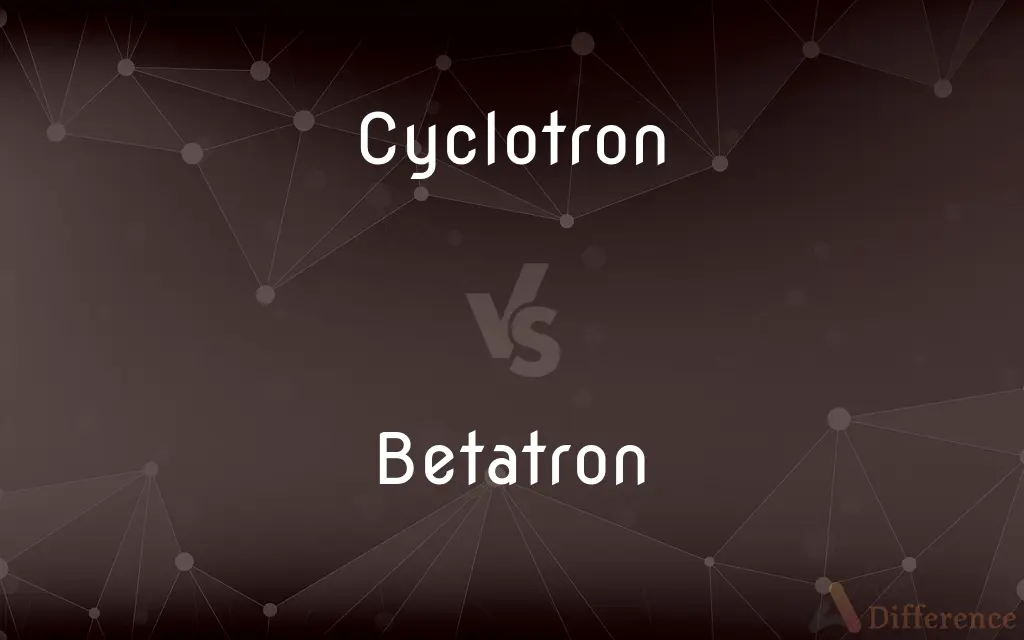Cyclotron vs. Betatron — What's the Difference?
By Tayyaba Rehman & Urooj Arif — Updated on March 24, 2024
Cyclotrons accelerate charged particles using a magnetic field and a fixed frequency electric field, while betatrons rely solely on a changing magnetic field to increase electron speeds.

Difference Between Cyclotron and Betatron
Table of Contents
ADVERTISEMENT
Key Differences
Cyclotrons are particle accelerators that use a combination of a constant magnetic field and a rapidly changing electric field to accelerate charged particles, such as protons, along a spiral path. The particles gain energy with each pass through the electric field, making cyclotrons effective for various applications, including medical isotope production. On the other hand, betatrons are designed to accelerate electrons through induction using a changing magnetic field, which effectively increases the energy of the electrons as they move in a circular path. This principle is akin to the operation of a transformer, with electrons in the secondary circuit.
The design of a cyclotron involves two D-shaped electrodes (dees) within a magnetic field. The oscillating electric field between the dees accelerates the particles each time they cross the gap, with the magnetic field keeping them on a circular path. This allows the cyclotron to accelerate particles to high energies in a compact space. Whereas, the betatron is built around a large magnet with a vacuum tube in the center, where electrons are accelerated. The changing magnetic field not only keeps the electrons on a circular path but also increases their speed, utilizing the magnetic flux through the electron's path for acceleration.
Cyclotrons are widely used in nuclear medicine to produce radioisotopes for diagnostic imaging and cancer therapy. These isotopes require particles to be accelerated to specific energies to initiate nuclear reactions. On the other hand, betatrons were historically used in radiography and cancer treatment, providing high-energy electrons suitable for deep tissue penetration in radiation therapy. However, the use of betatrons has declined with the development of more versatile and efficient accelerators.
One of the limitations of traditional cyclotrons is the relativistic mass increase of particles as they approach the speed of light, which requires adjustments to the magnetic field or the use of synchrocyclotrons to accommodate higher energies. Betatrons, in contrast, are limited by the maximum magnetic flux that can be generated and effectively linked with the electron orbit, restricting the maximum energy to which electrons can be accelerated.
In terms of practical applications, cyclotrons have found a broader range of uses beyond medical isotope production, including in physics research and the treatment of materials. Betatrons, while having played a crucial role in the development of particle physics and medical applications, are less commonly used today due to the advancements in accelerator technology that offer higher energies and more flexibility, such as synchrotrons and linear accelerators.
ADVERTISEMENT
Comparison Chart
Acceleration Mechanism
Magnetic and electric fields
Changing magnetic field only
Particle Type
Protons, deuterons, alpha particles
Electrons
Path Shape
Spiral
Circular
Main Uses
Medical isotope production, research
Historically used for radiography and radiation therapy
Energy Limitation
Relativistic effects limit energy
Limited by magnetic flux linkage
Compare with Definitions
Cyclotron
Utilizes a fixed frequency electric field.
The cyclotron’s electric field frequency remains constant during acceleration.
Betatron
Limited by the maximum magnetic flux that can be utilized.
The energy to which a betatron can accelerate electrons is capped by magnetic flux limits.
Cyclotron
A type of particle accelerator that uses a magnetic field and electric field to accelerate charged particles.
The cyclotron is crucial for producing medical isotopes.
Betatron
Operates on the principle similar to a transformer.
The betatron induces acceleration in electrons through a changing magnetic field.
Cyclotron
Designed with two D-shaped electrodes for particle acceleration.
Particles gain energy at each pass between the cyclotron's dees.
Betatron
Less commonly used with the advent of newer technologies.
The use of betatrons has declined in favor of more advanced accelerators.
Cyclotron
Effective for a range of particles including protons and alpha particles.
Cyclotrons can accelerate protons for use in cancer therapy.
Betatron
Specifically designed for electron acceleration.
Betatrons provide high-energy electrons for deep tissue medical treatments.
Cyclotron
Faces limitations at relativistic speeds due to mass increase.
As particles approach the speed of light in a cyclotron, their mass increases, requiring adjustments.
Betatron
A particle accelerator that accelerates electrons using a changing magnetic field.
The betatron accelerates electrons for industrial radiography.
Cyclotron
A cyclotron is a type of particle accelerator invented by Ernest O. Lawrence in 1929–1930 at the University of California, Berkeley, and patented in 1932. A cyclotron accelerates charged particles outwards from the center of a flat cylindrical vacuum chamber along a spiral path.
Betatron
A betatron is a type of cyclic particle accelerator. It is essentially a transformer with a torus-shaped vacuum tube as its secondary coil.
Cyclotron
An early particle accelerator in which charged subatomic particles generated at a central source are accelerated spirally outward in a plane perpendicular to a fixed magnetic field by an alternating electric field. A cyclotron is capable of generating particle energies between a few million and several tens of millions of electron volts.
Betatron
A magnetic induction electron accelerator capable of accelerating electrons to energies of several hundred million electron volts.
Cyclotron
An early particle accelerator in which charged particles were generated at a central source and accelerated spirally outward through a fixed magnetic field and alternating electric fields.
Betatron
(physics) A form of cyclotron used to accelerate electrons to high speed.
Cyclotron
A particle accelerator that imparts energies of several million electron-volts to rapidly moving particles; it is used in investigations in nuclear physics and particle physics.
Betatron
A type of particle accelerator which accelerates a continuous beam of electrons to high speeds by means of the electric field produced by changing magnetic flux.
Cyclotron
An accelerator that imparts energies of several million electron-volts to rapidly moving particles
Betatron
Accelerates a continuous beam of electrons to high speeds by means of the electric field produced by changing magnetic flux
Common Curiosities
What limits the energy that can be achieved in a betatron?
The maximum energy in a betatron is limited by the maximum magnetic flux that can be linked with the electron orbit.
For what purposes are cyclotrons used?
Cyclotrons are used for producing medical isotopes, physics research, and materials treatment.
Why are cyclotrons not effective at relativistic speeds?
At relativistic speeds, the mass of particles in a cyclotron increases, necessitating adjustments to maintain efficient acceleration, which becomes challenging.
What is the principle of operation for a cyclotron?
A cyclotron accelerates charged particles using a constant magnetic field and an oscillating electric field within two D-shaped electrodes.
Can cyclotrons accelerate electrons?
While cyclotrons are primarily used to accelerate protons and heavier ions, modifications and specific designs can also accelerate electrons.
What made betatrons important in medical applications?
Betatrons were significant for their ability to produce high-energy electrons for deep tissue penetration in radiation therapy.
How does a betatron work?
A betatron accelerates electrons through a vacuum tube using only a changing magnetic field, based on the principle of electromagnetic induction.
Why do cyclotrons have a spiral path for particle acceleration?
The spiral path in cyclotrons allows particles to gain energy over multiple passes through the electric field within a compact space.
What advancements have replaced betatrons?
Advancements such as synchrotrons and linear accelerators, offering higher energies and more flexibility, have largely replaced betatrons.
What is the difference in particle type acceleration between cyclotrons and betatrons?
Cyclotrons accelerate various charged particles like protons and alpha particles, whereas betatrons specifically accelerate electrons.
Can betatrons be used for physics research?
Historically, betatrons were used for physics research, but modern research often requires higher energy particles than betatrons can provide.
What has led to the decline in betatron use?
The development of more advanced and versatile accelerators, like synchrotrons and linear accelerators, has made betatrons less common.
How do cyclotrons produce medical isotopes?
Cyclotrons produce medical isotopes by accelerating particles to high energies to initiate nuclear reactions in target materials.
Share Your Discovery

Previous Comparison
Fascism vs. Militarism
Next Comparison
Iams vs. EukanubaAuthor Spotlight
Written by
Tayyaba RehmanTayyaba Rehman is a distinguished writer, currently serving as a primary contributor to askdifference.com. As a researcher in semantics and etymology, Tayyaba's passion for the complexity of languages and their distinctions has found a perfect home on the platform. Tayyaba delves into the intricacies of language, distinguishing between commonly confused words and phrases, thereby providing clarity for readers worldwide.
Co-written by
Urooj ArifUrooj is a skilled content writer at Ask Difference, known for her exceptional ability to simplify complex topics into engaging and informative content. With a passion for research and a flair for clear, concise writing, she consistently delivers articles that resonate with our diverse audience.
















































